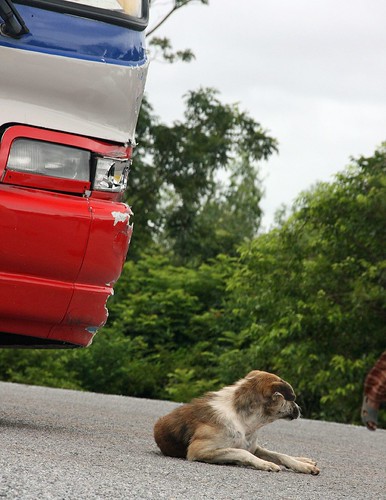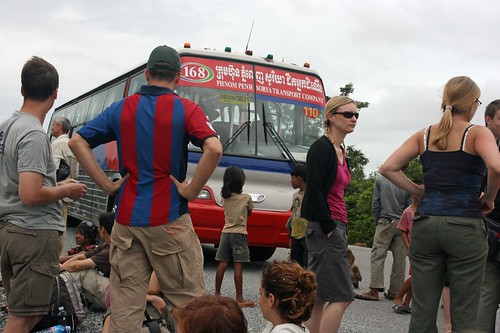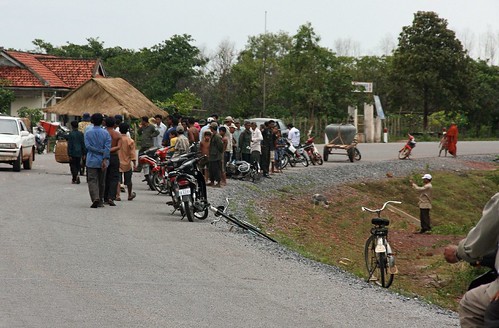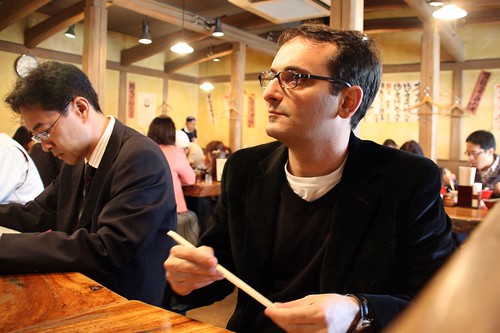Death on the Highway
[Warning: This post contains graphic descriptions of an accident.]
This morning my tour group boarded a bus in Kampot, on the South Coast of Cambodia, and set out on National Highway 3 for the beach resort of Sihanoukville, about 100 kilometers to the west. About 20 minutes into the trip I pulled out a novel and settled in for a good read. The bus jerked to the right. There was a loud thwack and crunch, that kind of sounds that scream collision. My seatmate, Kathe, turned to me with wide eyes and said we'd hit something. A sort of collective gasp and unease filled the cabin. But the bus continued to roll down the highway, the driver apparently unconcerned with the accident.
Two rows behind me and Kathe sat Sally and Renee, nurses from Adelaide, Australia. I heard Renee yell at the driver to stop, and only then did he pull over on the shoulder. Sally and Renee jumped off the bus and ran down the road while the rest of us tried to figure out what had happened.
Cambodians drive on the right, like in America. But that doesn't mean people follow rules, like staying on their side of the road. On the other side of the highway, a motorbike passed a car on the left. A third motorbike, with a driver and passenger, tried to speed ahead of the car and other motorbike by passing further on the left, which put them in the path of oncoming traffic. But for a space of about a foot, they would have been successful. They tried to swerve out of the way but ran into the left front bumper of the bus, causing minimal damage to coach and catastrophic damage to the motorbike and the men.

Bus Bumper
I left the bus and walked back along the highway towards a small but growing crowd. I could see Sally and Renee standing near a body on the pavement and a mangled motorbike. As I got closer I saw something on the pavement. My brain told me with was a bit of steak, then I realized it was a golf ball-sized chuck of flesh. I then noticed the second victim, the passenger, lying in a heap on a small slope next to the road. His arms were twisted behind his back and his shirt had been lifted over a motionless torso. I assumed he was dead, then saw that the right side of his head had been crushed, a pool of blood gathering in the grass. No one could survive those injuries.
I turned back to driver and was relieved to see that he was moving and conscious. But still no one was tending to him, no one even offering an ounce of comfort. Sally and Renee are trained professionals, yet the locals told them to not touch either man. If they intervened, and the men died, there was a chance that the victims' families would blame Sally and Renee for the deaths. In fact, no one would touch the men. It's not logical, yet it's the way things work here.
Nevertheless, Sally and Renee urged out tour guide, Kevin, a Khmer from Siem Reap, to step in, and he did, at risk to himself, to comfort the survivor. The man's left wrist was shattered, his hand hanging bloody and limp, yet he was responsive and answered Kevin's questions. He was in shock, but alive.

Tourists at the Scene
I wondered what would happen to the bus driver and heard that he had run into the rice fields. Even though he was not to blame, and tried to swerve out of the way of the motorbike, he would be blamed. Kevin said this blame would result in local villagers seeking vengeance and killing him on the spot. Could this be true? I then noticed a young woman lurking in the expanding crowd carrying a hatchet. Had she been working in the woodshed and come to see what happened or was she there with a more sinister purpose?
After fifteen minutes a trio of men lifted the ragged survivor into the bed of a truck and took off for the hospital in Kampot. I will never know what happened to the man, whether he survived or not. Sally and Renee said he will likely lose his left arm due to the extensive injuries and the lack of medical facilities in the region.
Meanwhile, the passenger, (his friend, brother, father, cousin?) lay motionless and uncovered by the side of the road. The crowd continued to grow, and included children and dogs. Gawkers roamed through the wreckage, kicking bits here and there. Young kids, four and five years old, stared at the corpse on the berm and the bits of gristle on the pavement. A pair of police officers showed up but did nothing more than spray-paint a circle around the wrecked motorbike.
My group returned to the bus. We knew there was nothing we could do but let Cambodia be Cambodia. This is not our home, things are not done the same way. Kevin told us that we should forget it, put it behind us, get back to our holiday. I felt queasy, and could see the concern in the faces of the other tourists. The Cambodians who had now gathered around the bus seemed to be unsure of whether they should check out the dead body or continue watching at the tourists. The whole scene was unreal, surreal, enlightening, frightening and disgusting.

Crowd at the Body
One man lost his life and another's life was ruined because of the space of a few inches. Perhaps a helmet would have saved the passenger's life. There are no answers; it was an accident, plain and simple. Yet, it showed me a side of Cambodian culture that no tour anywhere, anytime, would include in an itinerary. It was a reminder of the fragility of life. It was a reminder of the risks you take when traveling in developing countries. It was as eye-opening an experience as I've had these past six months. In fact, the journalist in me was thrilled to have the story. I'd go to Hell if I believed it existed.
A replacement bus arrived about thirty minutes after the collision. The somber group of foreigners filed back to their seats and the bus pulled away.
The dead man remained exposed and untouched by the side of the road.
This morning my tour group boarded a bus in Kampot, on the South Coast of Cambodia, and set out on National Highway 3 for the beach resort of Sihanoukville, about 100 kilometers to the west. About 20 minutes into the trip I pulled out a novel and settled in for a good read. The bus jerked to the right. There was a loud thwack and crunch, that kind of sounds that scream collision. My seatmate, Kathe, turned to me with wide eyes and said we'd hit something. A sort of collective gasp and unease filled the cabin. But the bus continued to roll down the highway, the driver apparently unconcerned with the accident.
Two rows behind me and Kathe sat Sally and Renee, nurses from Adelaide, Australia. I heard Renee yell at the driver to stop, and only then did he pull over on the shoulder. Sally and Renee jumped off the bus and ran down the road while the rest of us tried to figure out what had happened.
Cambodians drive on the right, like in America. But that doesn't mean people follow rules, like staying on their side of the road. On the other side of the highway, a motorbike passed a car on the left. A third motorbike, with a driver and passenger, tried to speed ahead of the car and other motorbike by passing further on the left, which put them in the path of oncoming traffic. But for a space of about a foot, they would have been successful. They tried to swerve out of the way but ran into the left front bumper of the bus, causing minimal damage to coach and catastrophic damage to the motorbike and the men.

I left the bus and walked back along the highway towards a small but growing crowd. I could see Sally and Renee standing near a body on the pavement and a mangled motorbike. As I got closer I saw something on the pavement. My brain told me with was a bit of steak, then I realized it was a golf ball-sized chuck of flesh. I then noticed the second victim, the passenger, lying in a heap on a small slope next to the road. His arms were twisted behind his back and his shirt had been lifted over a motionless torso. I assumed he was dead, then saw that the right side of his head had been crushed, a pool of blood gathering in the grass. No one could survive those injuries.
I turned back to driver and was relieved to see that he was moving and conscious. But still no one was tending to him, no one even offering an ounce of comfort. Sally and Renee are trained professionals, yet the locals told them to not touch either man. If they intervened, and the men died, there was a chance that the victims' families would blame Sally and Renee for the deaths. In fact, no one would touch the men. It's not logical, yet it's the way things work here.
Nevertheless, Sally and Renee urged out tour guide, Kevin, a Khmer from Siem Reap, to step in, and he did, at risk to himself, to comfort the survivor. The man's left wrist was shattered, his hand hanging bloody and limp, yet he was responsive and answered Kevin's questions. He was in shock, but alive.

I wondered what would happen to the bus driver and heard that he had run into the rice fields. Even though he was not to blame, and tried to swerve out of the way of the motorbike, he would be blamed. Kevin said this blame would result in local villagers seeking vengeance and killing him on the spot. Could this be true? I then noticed a young woman lurking in the expanding crowd carrying a hatchet. Had she been working in the woodshed and come to see what happened or was she there with a more sinister purpose?
After fifteen minutes a trio of men lifted the ragged survivor into the bed of a truck and took off for the hospital in Kampot. I will never know what happened to the man, whether he survived or not. Sally and Renee said he will likely lose his left arm due to the extensive injuries and the lack of medical facilities in the region.
Meanwhile, the passenger, (his friend, brother, father, cousin?) lay motionless and uncovered by the side of the road. The crowd continued to grow, and included children and dogs. Gawkers roamed through the wreckage, kicking bits here and there. Young kids, four and five years old, stared at the corpse on the berm and the bits of gristle on the pavement. A pair of police officers showed up but did nothing more than spray-paint a circle around the wrecked motorbike.
My group returned to the bus. We knew there was nothing we could do but let Cambodia be Cambodia. This is not our home, things are not done the same way. Kevin told us that we should forget it, put it behind us, get back to our holiday. I felt queasy, and could see the concern in the faces of the other tourists. The Cambodians who had now gathered around the bus seemed to be unsure of whether they should check out the dead body or continue watching at the tourists. The whole scene was unreal, surreal, enlightening, frightening and disgusting.

One man lost his life and another's life was ruined because of the space of a few inches. Perhaps a helmet would have saved the passenger's life. There are no answers; it was an accident, plain and simple. Yet, it showed me a side of Cambodian culture that no tour anywhere, anytime, would include in an itinerary. It was a reminder of the fragility of life. It was a reminder of the risks you take when traveling in developing countries. It was as eye-opening an experience as I've had these past six months. In fact, the journalist in me was thrilled to have the story. I'd go to Hell if I believed it existed.
A replacement bus arrived about thirty minutes after the collision. The somber group of foreigners filed back to their seats and the bus pulled away.
The dead man remained exposed and untouched by the side of the road.



1 Comments:
man.... terrible, sad and horrifying. but enlightening too. thanks klein. be safe!
Post a Comment
<< Home